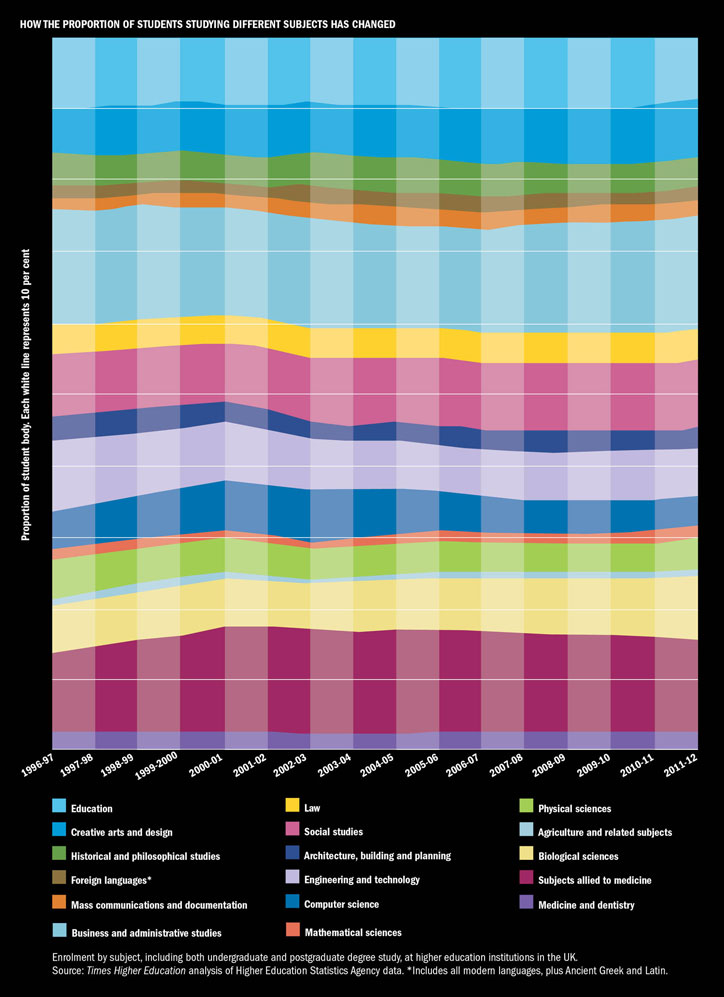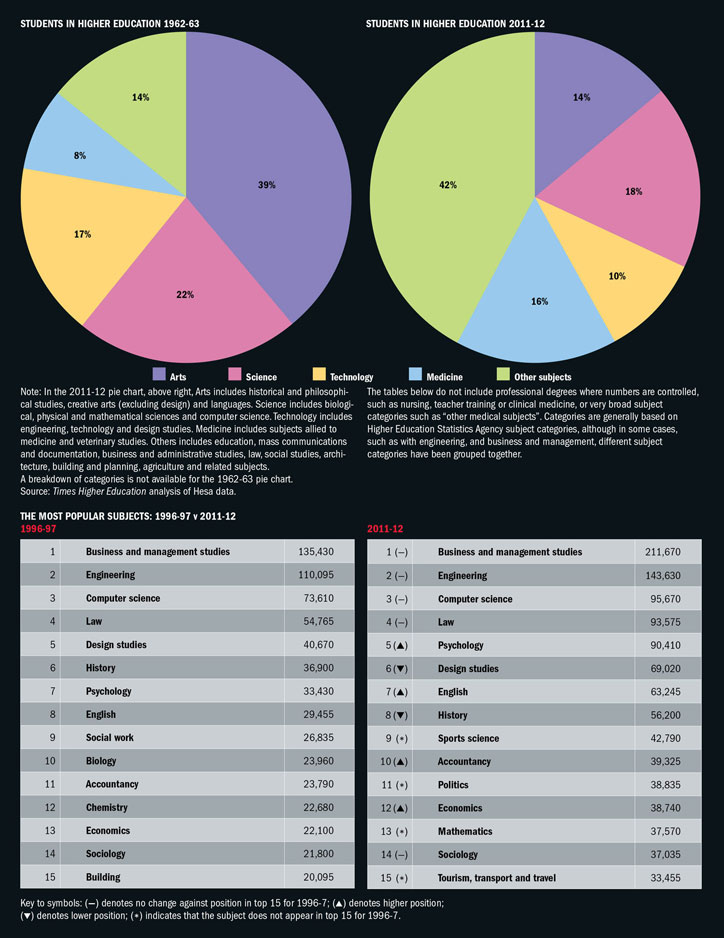Download full data tables for every subject and every year
Tony Blair’s general election victory in 1997 was famously heralded by the New Labour anthem Things Can Only Get Better. And for higher education it certainly ushered in an era of expansion: the number of university students increased in all but one of the years the party was in power.
Now, after a slight dip in undergraduate numbers following the introduction of £9,000 fees beginning in the 2012-13 academic year, the taps are about to be turned on once again.
In December, the chancellor George Osborne shocked the sector by announcing that the cap on undergraduate places would be removed by 2015-16, allowing an anticipated 60,000 extra students to enter higher education per year. As admissions officers hungrily await a new boom in student numbers, it is worth looking back at exactly who benefited from previous expansion.
Just as the UK’s rising gross domestic product disguised increasing inequality during the Labour Party’s period in power, has the rise in student numbers masked differences by subject, with some faculties gorging on growth as others received only scraps from the table?
Times Higher Education has analysed data from the Higher Education Statistics Agency that track which subjects were studied by higher education students across the UK from 1996-97 to 2011-12. The data draw together figures for home and overseas students, studying both full-time and part-time at undergraduate and postgraduate level.
One of the most remarkable stories that emerges from this 16-year period is the rise of “new” subjects, some of which have shot from relative obscurity to prominence, overtaking disciplines that have been ensconced in the academy for hundreds of years.
So which subjects have witnessed a meteoric rise? Perhaps the most impressive example of growth is that of media studies, which (ironically) has also suffered the most derision in the media.
In 1996-97, the subject had just 6,890 students, fewer than were studying history of art. But by 2011-12, this tally had grown by 360 per cent to 31,860 students (12 per cent of them studying at postgraduate level), making media studies a bigger discipline than mechanical engineering, biology or chemistry (see chart, below).
“It’s such an interesting subject,” argues Sally Feldman, who until 2012 was dean of media, arts and design at the University of Westminster, which in the 1990s became one of the first UK higher education institutions to offer the subject. “Media is such a barometer and reflection of our society.”
But she also acknowledges that the perceived glamour of a career in television may have played a part in its popularity. “If you ask young people what they want to do these days, they want to be footballers or presenters on MTV,” she explains.
Feldman believes, however, that the term “media studies” is so broad that it has outlived its usefulness; it encompasses courses that are largely theoretical and sociological as well as those that are highly practical. As a result, Westminster no longer offers “media studies” programmes, opting instead for degree courses in journalism and mass communication, and public relations and advertising.
These subjects – all categorised separately by Hesa – have also grown rapidly. Journalism has more than quintupled in numbers since 1996-97, when it had just 2,240 students, to 12,870 students today (17 per cent of whom are postgraduates). The cohort of those studying publishing has tripled in size to 1,370 students in 2011-12, almost half of whom are postgraduates.
Both journalism and publishing are fiercely competitive industries in which it can be difficult to get a job, and although many postgraduate journalism courses are highly regarded in the industry, some journalists have viewed the growth in journalism courses at a time of contraction in the industry with suspicion.
In 2009, Tim Luckhurst, professor of journalism at the University of Kent, told a conference that there was “an element of fraud in journalism education”.
Others argue that the discipline’s growth is justified because journalism degrees provide graduates with useful transferable skills.
Student enrolments by year
In 2002-03, Hesa made minor revisions to its list of subjects, introducing several categories that previously had not been recorded separately.
This seemingly dry exercise in reclassification opens a window on a number of other fields that burst on to the scene during the New Labour years. In 1996-97, there was no category for sports science, for example, but by 2011-12, it boasted 42,790 students, a growth of nearly 150 per cent since 2002-03.
Complementary medicine, also introduced as a Hesa category during this period, now has more than 7,000 students, up from fewer than 3,000 students in 2002-03 – a statistic that will fail to impress its detractors. The numbers studying imaginative writing, a category that includes creative writing, have reached similar levels.
Also granted its own Hesa classification in 2002-03 was “tourism, transport and travel”, which has seen its numbers grow dramatically by almost 300 per cent to more than 33,000, in the ensuing nine years. Cinematics and photography has also been added to the list, and is now taken by nearly 23,000 students.
Golf studies, the go-to “Mickey Mouse” course for scathing commentators, does not have its own category. The phrase was popularised in 2003 by Margaret Hodge, who was then minister of state with responsibility for lifelong learning, further and higher education, although she did not say which subjects she thought deserved the tag.
Such courses have found a champion in Boris Johnson, former shadow minister for higher education and now mayor of London, who has defended their relevance to the labour market. Writing in The Daily Telegraph in 2007, Johnson said: “We can laugh at degrees in aromatherapy and equine science, but they are just as vocational as degrees in law or medicine, except that they are tailored to the enormous expansion of the service economy.”
Feldman points out that the discipline of English literature was similarly ridiculed when it was introduced in the 19th century, as was sociology in the 1960s. Attacking “new” subjects such as media studies, she says, is often a proxy for ridiculing post-1992 universities and she believes that “some of the derision about it comes from the older universities out of jealousy”.
Still, Feldman acknowledges that stinging criticism of media studies from some quarters may have led parents to dissuade their children from studying the subject, and contributed to a slowing down of the discipline’s growth since 2003-04.
The explosion in the number of new disciplines during the New Labour years is only part of the story. During the period analysed, the total number of students pursuing higher education in the UK increased by 42.2 per cent, and many established humanities and social science disciplines expanded even more rapidly and therefore increased their share of the student body.
For example, the number of politics students has grown by 125 per cent, while its social science counterpart, economics, has expanded by 75 per cent. Classics, although still a minnow with 5,205 students in 2011-12, has doubled in size.
Psychology has become hugely popular, too. More than 90,000 students took the subject in 2011-12, up from 33,430 in 1996-97. In all four of these disciplines, growth has been relatively steady across the 16-year period.
While there have been huge jumps in other subjects, statistical difficulties mean that these increases may not be all they seem. In 2002-03, Hesa changed the way it recorded joint subject degrees: instead of allocating students entirely to their “major” subject, it split them between both.
The number of students taking English as a subject of study has ballooned by 115 per cent since 1996-97. But much of this occurred when the methodology changed in 2002-03, and so could simply be attributable to a better recognition of students taking English in combination with another subject, rather than real growth. Since then it has grown by only 15 per cent – in line with the overall rate of growth in student numbers between 2002-03 and 2011-12 (also 15 per cent).
How the proportion of students studying different subjects has changed
History courses gained about 20,000 students during this period to reach a cohort of 56,200 students by 2011-12, an increase of just over 50 per cent. But around half of this increase was recorded in 2002-03, after the change in Hesa’s methodology. The same caveat applies to figures for enrolments in philosophy, whose student cohort has grown by 119 per cent since 1996-97, but just 22 per cent since 2002-03.
On the surface, fears about the future of foreign languages seem unfounded: between 1996-97 and 2011-12, the number of students studying French rose 50.4 per cent, while German (45.2 per cent) and Spanish (237.5 per cent) also grew. Yet, as with English, this could simply be down to Hesa better recording languages when taken as a second subject following the methodology change of 2002-03, which resulted in a huge spike in the figures for some subjects. Since then, the picture appears bleak: French student numbers actually fell by 14.2 per cent, German by 17.1 per cent, and Spanish grew by only9.1 per cent.
And this is before the introduction of higher tuition fees, which the British Academy warned last year was putting students off four-year (and therefore more costly) foreign language courses, which it said could lead to a “vicious cycle of monolingualism” in the UK.
There is one brighter note: the number of students doing Chinese studies has almost tripled since 1996-97, just as the country has emerged as a new economic superpower to rival the United States.
Still, the picture in humanities is probably more positive than in the major lab-based sciences. In the period studied, enrolment in physics grew by 26 per cent, biology 22 per cent and “molecular biology, biophysics and biochemistry” by 34.3 per cent, meaning that, when compared with the total growth of 42.2 per cent, all of these subjects’ share of the student body actually shrank.
Chemistry was the only major subject that witnessed a decline in numbers. Some of the probable reasons behind its 1.3 per cent dip in students are illustrative of the broader problems the lab-based sciences have had in capitalising on the protracted boom in students.
Jim Iley, director of science and education at the Royal Society of Chemistry and visiting professor in the Faculty of Science at The Open University, notes that the subject was hit by a series of department closures from the mid-1990s to the early 2000s. Departments that failed to attract significant amounts of research income “were seen to be a cost and drain on university finances”, he explains. It is “very difficult to make science departments run at a profit…you have to have a strong research income”, he argues.
In an era when research cash is becoming ever more concentrated, this may not bode well for the future of science, technology, engineering and mathematics (STEM) subjects at some universities, although the coalition government has sought to protect these disciplines with Higher Education Funding Council for England teaching grants since the move to a largely tuition fee-funded teaching system.
Iley also says that chemistry suffered from an image problem: it was seen as leading to “highly polluting” jobs in heavy industry, although he insists that this perception has since changed and that chemistry is now seen as rather more high-tech.
Encouragingly, however, the overall picture for lab-based subjects has improved since 2002-03, and even chemistry grew by 18 per cent over this period.
As for engineering and technology, the middle two letters of the STEM acronym, student numbers have grown by an underwhelming 21 per cent since 1996-97.
Even more worryingly for those who fear for the UK’s engineering and technology base, of the 28,000 students this subject area has gained since 1996-97, 21,000 have been from overseas.
Only in mathematics – which requires no more specialist equipment or labs than a humanities subject – have numbers grown more than average, and dramatically so. They have risen by 134 per cent since 1996-97, and by 87 per cent since 2002-03.
Students in higher education/the most popular subjects
Tony Mann, director of resources at the University of Greenwich’s School of Computing and Mathematical Sciences, thinks that the subject’s new popularity is partly down to concerted efforts to promote maths in schools, so that more students are now taking the subject at A level.
“There is more awareness in schools and colleges of the career opportunities for maths graduates,” he says. There are also new types of maths courses – such as Greenwich’s financial mathematics programme – that appeal to students, he believes.
While student demand is one factor affecting rates of growth, another is the comparative cost of running courses in different subjects. Have universities been more able and willing to expand lower-cost, lecture-based disciplines? Or, more cynically, have they done so to reap profits that can be invested elsewhere?
Iley points out that it can be more challenging to expand science subjects because they require the construction of new labs, while Jürgen Enders, professor of higher education at the University of Southampton, says that “low-cost/high-fee fields can be attractive for universities – think of universities in some countries using their business schools as cash cows”.
Indeed, it was a classroom-based group of subjects – business and administrative studies – that remained the most popular discipline throughout the entire 16-year period (see ‘How the proportion of students studying different subjects has changed’ graph, above). By 2011-12, this group of subjects had 363,860 students (a rise of 64 per cent on 1996-97), including 211,670 studying business and management.
What is more, about two-thirds of the rise in business and administration numbers is down to an increase in international students, who usually pay much higher tuition fees. However, Enders points out that business courses have also expanded in countries whose publicly funded higher education institutions do not charge tuition fees, suggesting that student demand is a driver.
For Stefano Harney, professor of strategic management (education) at Singapore Management University, the rise of business studies represents a “hedge” by students against the risks associated with rising debt and insecure job prospects. Students without family wealth perceive subjects associated with the public or not-for-profit sector as higher risk, he argues.
In the UK, unlike countries whose sectors are subject to greater central planning, universities are free to expand and shrink subject areas as they see fit and in response to student demand. But with concerns about an “oversupply” of graduates in some areas (such as journalism), and an “undersupply” of graduates in others (such as STEM), does this system make sense?
Sir Peter Scott, professor of higher education studies at the Institute of Education, University of London, thinks that it does.
“I am not surprised by the popularity of business and management and creative and cultural subjects, including the much-maligned media studies, because these are among the most important areas of economic activity in 21st-century Britain,” he says.
“Universities have a much better idea of the student market, and students have a much better idea of which subjects lead to attractive employment, than most politicians (and media commentators),” Scott argues.
For all the contrasting fortunes of various corners of the academy, it might seem churlish not to end on a positive note. With the exception of chemistry, every major subject experienced an increase in student numbers from 1996-97 to 2011-12. What other area of British public or private life can boast such consistent growth across almost every facet of its mission? And if George Osborne is to be believed, a new era of expansion awaits just the other side of the 2015 general election.
Download full data tables for every subject and every year
Robbins: 50 years on
While Lord Robbins’ 1963 report on higher education opened the door to the huge expansion of higher education during the past half century, the economist might have been surprised to see what the students of today are studying.
Business and management education was the biggest subject in both 1996-97 and 2011-12, and numbers have grown by 56 per cent in this period.
The document included a breakdown of the proportion of students studying arts, science, technology, medical subjects and “other” subjects, including business, in 1962-63 (see pie charts, above).
Times Higher Education has worked out a comparable breakdown using Higher Education Statistics Agency data.
The most striking contrast is that in Robbins’ day, almost 40 per cent of students studied an arts subject, but by 2011-12 that cohort had fallen to 14 per cent of the whole.
Rather than envisioning the rise of dozens of business schools, the Robbins report recommended that “many more” students should take a scientific education to prepare them for the administration of “industry, in commerce and in the public service”.
It also predicted that by 1980 the proportion of students studying medical subjects, both at universities and elsewhere, would have halved to 4 per cent of the total. In fact, by 2011-12, it had risen to 16 per cent.
Register to continue
Why register?
- Registration is free and only takes a moment
- Once registered, you can read 3 articles a month
- Sign up for our newsletter
Subscribe
Or subscribe for unlimited access to:
- Unlimited access to news, views, insights & reviews
- Digital editions
- Digital access to THE’s university and college rankings analysis
Already registered or a current subscriber? Login







